Student Assessment: HLTINF001 Comply with Infection Control
VerifiedAdded on 2022/12/27
|14
|4608
|11
Homework Assignment
AI Summary
This document presents a student's comprehensive responses to an assessment for the HLTINF001 unit, focusing on complying with infection prevention and control policies and procedures within a healthcare setting. The assessment covers a wide range of topics, including medical and surgical handwashing techniques, situations requiring soap and water hand hygiene, and non-clinical moments for hand hygiene. It explores hand care guidelines, the use of personal protective equipment (PPE), and the roles of an enrolled nurse in managing blood or body fluid spills. The assessment also addresses the disposal of sharps and clinical waste, additional precautions for patients with H1N1 influenza, and the identification of hospital work environment hazards. Furthermore, it delves into the chain of infection, factors increasing susceptibility to infection, the reprocessing of reusable medical devices, and examples of infections caused by specific pathogens. The document also clarifies the differences between harmless microorganisms and pathogens, as well as colonization, infection, and disease. Routine cleaning procedures for various surfaces, surface cleaning frequencies, and enrolled nurse responsibilities in infection prevention and control are outlined. Finally, the assessment identifies modes of disease transmission, sources of infection, susceptible hosts, and incubation periods for specific conditions.
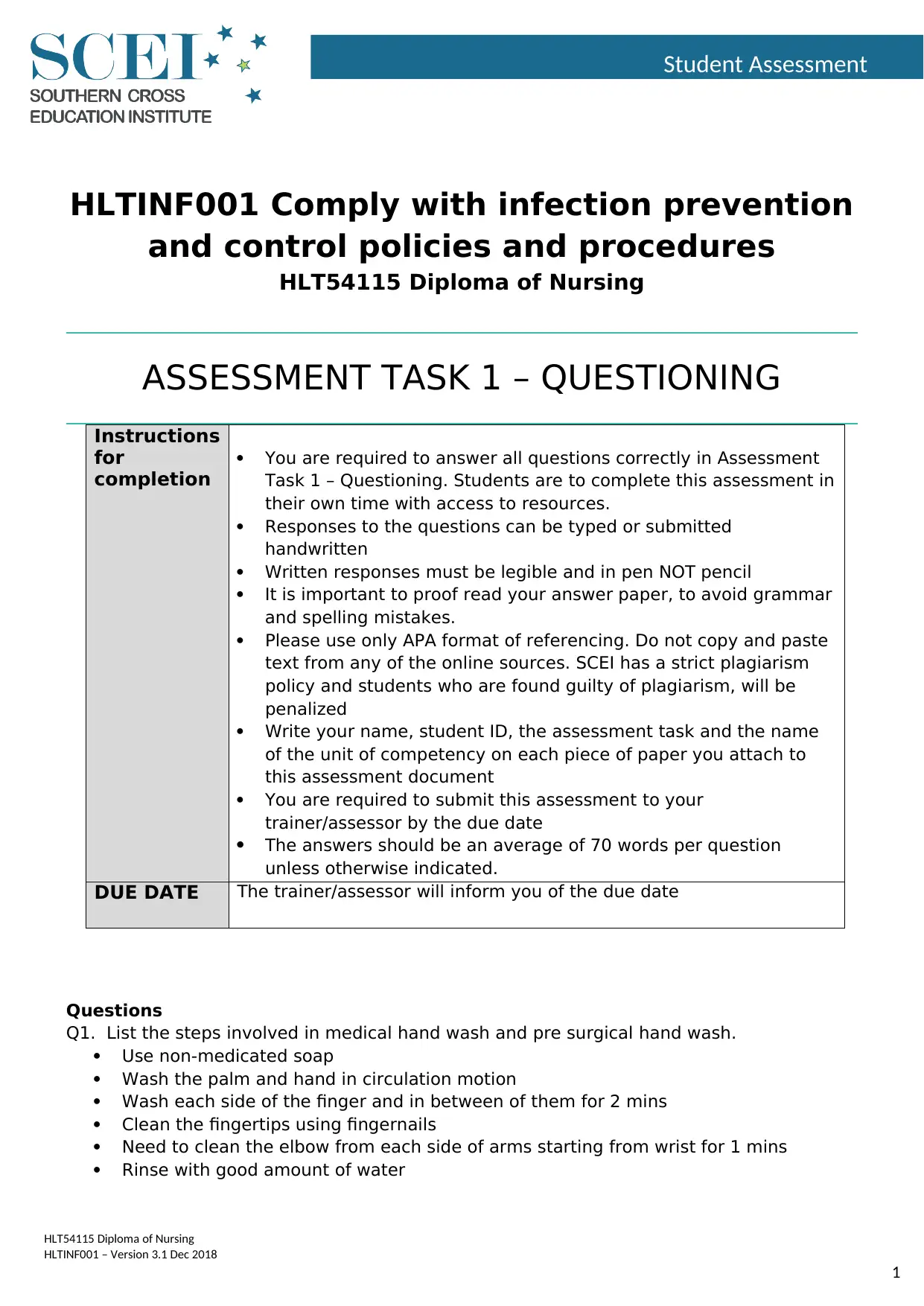
Student Assessment
HLTINF001 Comply with infection prevention
and control policies and procedures
HLT54115 Diploma of Nursing
ASSESSMENT TASK 1 – QUESTIONING
Instructions
for
completion
You are required to answer all questions correctly in Assessment
Task 1 – Questioning. Students are to complete this assessment in
their own time with access to resources.
Responses to the questions can be typed or submitted
handwritten
Written responses must be legible and in pen NOT pencil
It is important to proof read your answer paper, to avoid grammar
and spelling mistakes.
Please use only APA format of referencing. Do not copy and paste
text from any of the online sources. SCEI has a strict plagiarism
policy and students who are found guilty of plagiarism, will be
penalized
Write your name, student ID, the assessment task and the name
of the unit of competency on each piece of paper you attach to
this assessment document
You are required to submit this assessment to your
trainer/assessor by the due date
The answers should be an average of 70 words per question
unless otherwise indicated.
DUE DATE The trainer/assessor will inform you of the due date
Questions
Q1. List the steps involved in medical hand wash and pre surgical hand wash.
Use non-medicated soap
Wash the palm and hand in circulation motion
Wash each side of the finger and in between of them for 2 mins
Clean the fingertips using fingernails
Need to clean the elbow from each side of arms starting from wrist for 1 mins
Rinse with good amount of water
HLT54115 Diploma of Nursing
HLTINF001 – Version 3.1 Dec 2018
1
HLTINF001 Comply with infection prevention
and control policies and procedures
HLT54115 Diploma of Nursing
ASSESSMENT TASK 1 – QUESTIONING
Instructions
for
completion
You are required to answer all questions correctly in Assessment
Task 1 – Questioning. Students are to complete this assessment in
their own time with access to resources.
Responses to the questions can be typed or submitted
handwritten
Written responses must be legible and in pen NOT pencil
It is important to proof read your answer paper, to avoid grammar
and spelling mistakes.
Please use only APA format of referencing. Do not copy and paste
text from any of the online sources. SCEI has a strict plagiarism
policy and students who are found guilty of plagiarism, will be
penalized
Write your name, student ID, the assessment task and the name
of the unit of competency on each piece of paper you attach to
this assessment document
You are required to submit this assessment to your
trainer/assessor by the due date
The answers should be an average of 70 words per question
unless otherwise indicated.
DUE DATE The trainer/assessor will inform you of the due date
Questions
Q1. List the steps involved in medical hand wash and pre surgical hand wash.
Use non-medicated soap
Wash the palm and hand in circulation motion
Wash each side of the finger and in between of them for 2 mins
Clean the fingertips using fingernails
Need to clean the elbow from each side of arms starting from wrist for 1 mins
Rinse with good amount of water
HLT54115 Diploma of Nursing
HLTINF001 – Version 3.1 Dec 2018
1
Paraphrase This Document
Need a fresh take? Get an instant paraphrase of this document with our AI Paraphraser
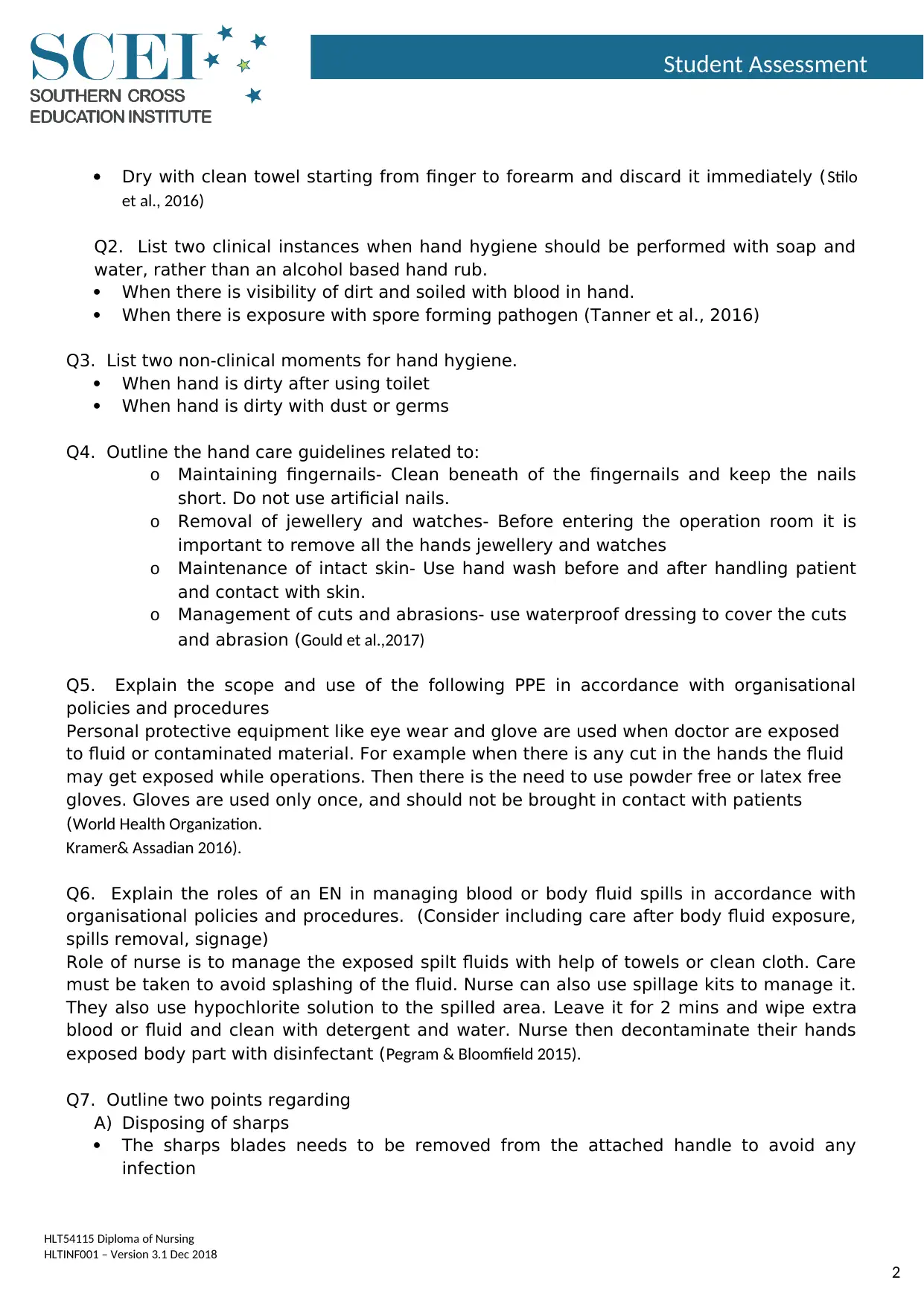
Student Assessment
Dry with clean towel starting from finger to forearm and discard it immediately (Stilo
et al., 2016)
Q2. List two clinical instances when hand hygiene should be performed with soap and
water, rather than an alcohol based hand rub.
When there is visibility of dirt and soiled with blood in hand.
When there is exposure with spore forming pathogen (Tanner et al., 2016)
Q3. List two non-clinical moments for hand hygiene.
When hand is dirty after using toilet
When hand is dirty with dust or germs
Q4. Outline the hand care guidelines related to:
o Maintaining fingernails- Clean beneath of the fingernails and keep the nails
short. Do not use artificial nails.
o Removal of jewellery and watches- Before entering the operation room it is
important to remove all the hands jewellery and watches
o Maintenance of intact skin- Use hand wash before and after handling patient
and contact with skin.
o Management of cuts and abrasions- use waterproof dressing to cover the cuts
and abrasion (Gould et al.,2017)
Q5. Explain the scope and use of the following PPE in accordance with organisational
policies and procedures
Personal protective equipment like eye wear and glove are used when doctor are exposed
to fluid or contaminated material. For example when there is any cut in the hands the fluid
may get exposed while operations. Then there is the need to use powder free or latex free
gloves. Gloves are used only once, and should not be brought in contact with patients
(World Health Organization.
Kramer& Assadian 2016).
Q6. Explain the roles of an EN in managing blood or body fluid spills in accordance with
organisational policies and procedures. (Consider including care after body fluid exposure,
spills removal, signage)
Role of nurse is to manage the exposed spilt fluids with help of towels or clean cloth. Care
must be taken to avoid splashing of the fluid. Nurse can also use spillage kits to manage it.
They also use hypochlorite solution to the spilled area. Leave it for 2 mins and wipe extra
blood or fluid and clean with detergent and water. Nurse then decontaminate their hands
exposed body part with disinfectant (Pegram & Bloomfield 2015).
Q7. Outline two points regarding
A) Disposing of sharps
The sharps blades needs to be removed from the attached handle to avoid any
infection
HLT54115 Diploma of Nursing
HLTINF001 – Version 3.1 Dec 2018
2
Dry with clean towel starting from finger to forearm and discard it immediately (Stilo
et al., 2016)
Q2. List two clinical instances when hand hygiene should be performed with soap and
water, rather than an alcohol based hand rub.
When there is visibility of dirt and soiled with blood in hand.
When there is exposure with spore forming pathogen (Tanner et al., 2016)
Q3. List two non-clinical moments for hand hygiene.
When hand is dirty after using toilet
When hand is dirty with dust or germs
Q4. Outline the hand care guidelines related to:
o Maintaining fingernails- Clean beneath of the fingernails and keep the nails
short. Do not use artificial nails.
o Removal of jewellery and watches- Before entering the operation room it is
important to remove all the hands jewellery and watches
o Maintenance of intact skin- Use hand wash before and after handling patient
and contact with skin.
o Management of cuts and abrasions- use waterproof dressing to cover the cuts
and abrasion (Gould et al.,2017)
Q5. Explain the scope and use of the following PPE in accordance with organisational
policies and procedures
Personal protective equipment like eye wear and glove are used when doctor are exposed
to fluid or contaminated material. For example when there is any cut in the hands the fluid
may get exposed while operations. Then there is the need to use powder free or latex free
gloves. Gloves are used only once, and should not be brought in contact with patients
(World Health Organization.
Kramer& Assadian 2016).
Q6. Explain the roles of an EN in managing blood or body fluid spills in accordance with
organisational policies and procedures. (Consider including care after body fluid exposure,
spills removal, signage)
Role of nurse is to manage the exposed spilt fluids with help of towels or clean cloth. Care
must be taken to avoid splashing of the fluid. Nurse can also use spillage kits to manage it.
They also use hypochlorite solution to the spilled area. Leave it for 2 mins and wipe extra
blood or fluid and clean with detergent and water. Nurse then decontaminate their hands
exposed body part with disinfectant (Pegram & Bloomfield 2015).
Q7. Outline two points regarding
A) Disposing of sharps
The sharps blades needs to be removed from the attached handle to avoid any
infection
HLT54115 Diploma of Nursing
HLTINF001 – Version 3.1 Dec 2018
2
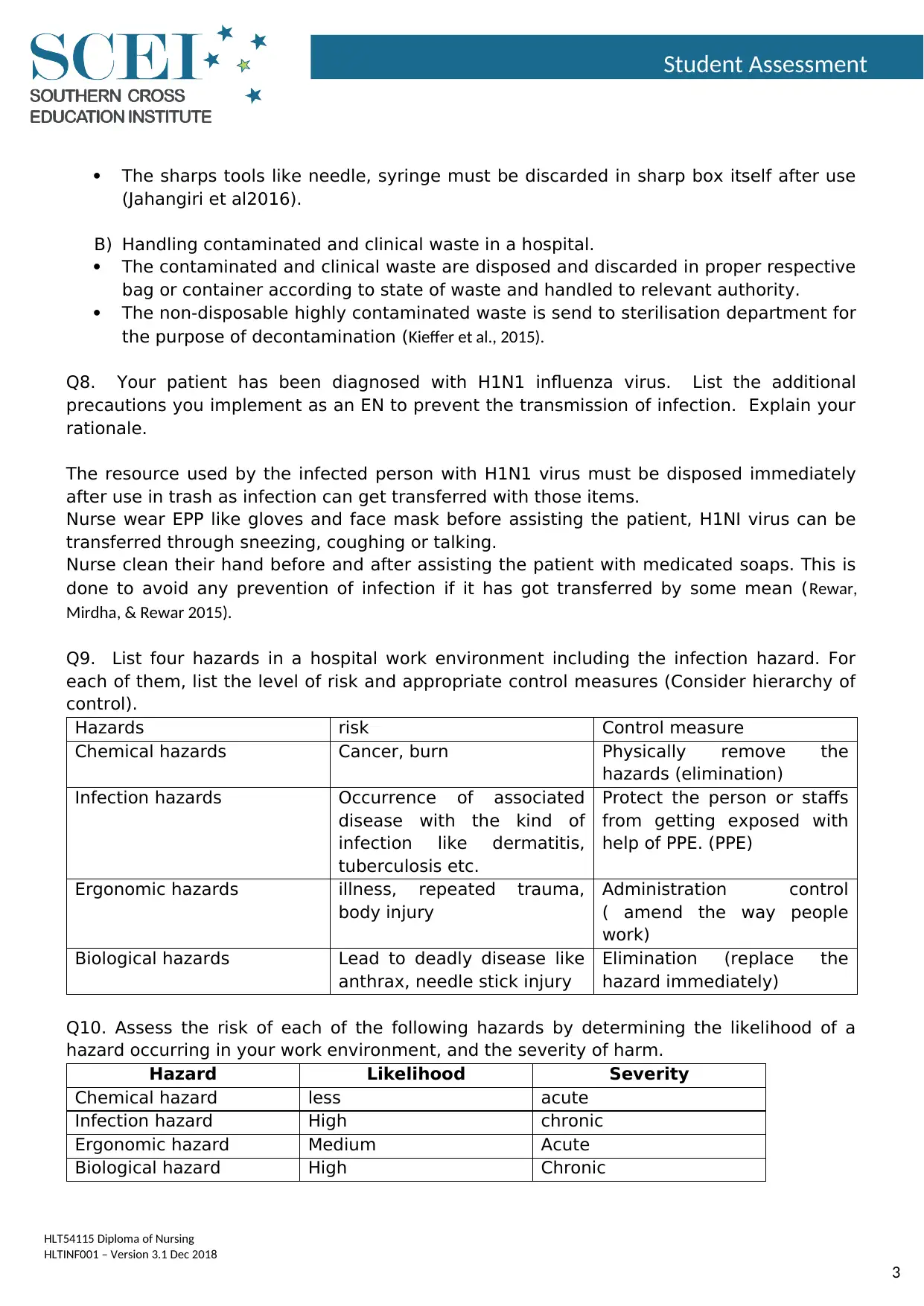
Student Assessment
The sharps tools like needle, syringe must be discarded in sharp box itself after use
(Jahangiri et al2016).
B) Handling contaminated and clinical waste in a hospital.
The contaminated and clinical waste are disposed and discarded in proper respective
bag or container according to state of waste and handled to relevant authority.
The non-disposable highly contaminated waste is send to sterilisation department for
the purpose of decontamination (Kieffer et al., 2015).
Q8. Your patient has been diagnosed with H1N1 influenza virus. List the additional
precautions you implement as an EN to prevent the transmission of infection. Explain your
rationale.
The resource used by the infected person with H1N1 virus must be disposed immediately
after use in trash as infection can get transferred with those items.
Nurse wear EPP like gloves and face mask before assisting the patient, H1NI virus can be
transferred through sneezing, coughing or talking.
Nurse clean their hand before and after assisting the patient with medicated soaps. This is
done to avoid any prevention of infection if it has got transferred by some mean (Rewar,
Mirdha, & Rewar 2015).
Q9. List four hazards in a hospital work environment including the infection hazard. For
each of them, list the level of risk and appropriate control measures (Consider hierarchy of
control).
Hazards risk Control measure
Chemical hazards Cancer, burn Physically remove the
hazards (elimination)
Infection hazards Occurrence of associated
disease with the kind of
infection like dermatitis,
tuberculosis etc.
Protect the person or staffs
from getting exposed with
help of PPE. (PPE)
Ergonomic hazards illness, repeated trauma,
body injury
Administration control
( amend the way people
work)
Biological hazards Lead to deadly disease like
anthrax, needle stick injury
Elimination (replace the
hazard immediately)
Q10. Assess the risk of each of the following hazards by determining the likelihood of a
hazard occurring in your work environment, and the severity of harm.
Hazard Likelihood Severity
Chemical hazard less acute
Infection hazard High chronic
Ergonomic hazard Medium Acute
Biological hazard High Chronic
HLT54115 Diploma of Nursing
HLTINF001 – Version 3.1 Dec 2018
3
The sharps tools like needle, syringe must be discarded in sharp box itself after use
(Jahangiri et al2016).
B) Handling contaminated and clinical waste in a hospital.
The contaminated and clinical waste are disposed and discarded in proper respective
bag or container according to state of waste and handled to relevant authority.
The non-disposable highly contaminated waste is send to sterilisation department for
the purpose of decontamination (Kieffer et al., 2015).
Q8. Your patient has been diagnosed with H1N1 influenza virus. List the additional
precautions you implement as an EN to prevent the transmission of infection. Explain your
rationale.
The resource used by the infected person with H1N1 virus must be disposed immediately
after use in trash as infection can get transferred with those items.
Nurse wear EPP like gloves and face mask before assisting the patient, H1NI virus can be
transferred through sneezing, coughing or talking.
Nurse clean their hand before and after assisting the patient with medicated soaps. This is
done to avoid any prevention of infection if it has got transferred by some mean (Rewar,
Mirdha, & Rewar 2015).
Q9. List four hazards in a hospital work environment including the infection hazard. For
each of them, list the level of risk and appropriate control measures (Consider hierarchy of
control).
Hazards risk Control measure
Chemical hazards Cancer, burn Physically remove the
hazards (elimination)
Infection hazards Occurrence of associated
disease with the kind of
infection like dermatitis,
tuberculosis etc.
Protect the person or staffs
from getting exposed with
help of PPE. (PPE)
Ergonomic hazards illness, repeated trauma,
body injury
Administration control
( amend the way people
work)
Biological hazards Lead to deadly disease like
anthrax, needle stick injury
Elimination (replace the
hazard immediately)
Q10. Assess the risk of each of the following hazards by determining the likelihood of a
hazard occurring in your work environment, and the severity of harm.
Hazard Likelihood Severity
Chemical hazard less acute
Infection hazard High chronic
Ergonomic hazard Medium Acute
Biological hazard High Chronic
HLT54115 Diploma of Nursing
HLTINF001 – Version 3.1 Dec 2018
3
⊘ This is a preview!⊘
Do you want full access?
Subscribe today to unlock all pages.

Trusted by 1+ million students worldwide
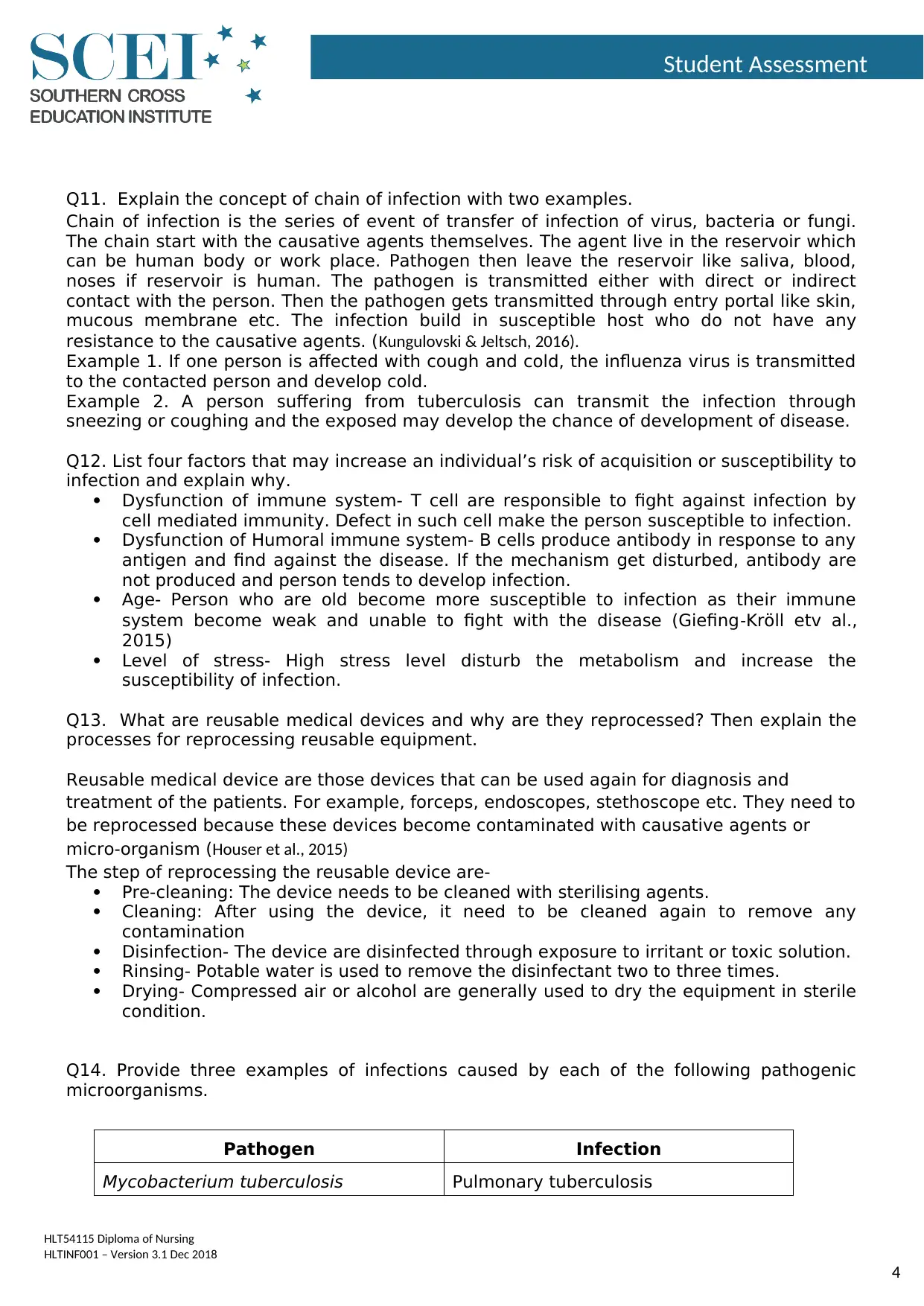
Student Assessment
Q11. Explain the concept of chain of infection with two examples.
Chain of infection is the series of event of transfer of infection of virus, bacteria or fungi.
The chain start with the causative agents themselves. The agent live in the reservoir which
can be human body or work place. Pathogen then leave the reservoir like saliva, blood,
noses if reservoir is human. The pathogen is transmitted either with direct or indirect
contact with the person. Then the pathogen gets transmitted through entry portal like skin,
mucous membrane etc. The infection build in susceptible host who do not have any
resistance to the causative agents. (Kungulovski & Jeltsch, 2016).
Example 1. If one person is affected with cough and cold, the influenza virus is transmitted
to the contacted person and develop cold.
Example 2. A person suffering from tuberculosis can transmit the infection through
sneezing or coughing and the exposed may develop the chance of development of disease.
Q12. List four factors that may increase an individual’s risk of acquisition or susceptibility to
infection and explain why.
Dysfunction of immune system- T cell are responsible to fight against infection by
cell mediated immunity. Defect in such cell make the person susceptible to infection.
Dysfunction of Humoral immune system- B cells produce antibody in response to any
antigen and find against the disease. If the mechanism get disturbed, antibody are
not produced and person tends to develop infection.
Age- Person who are old become more susceptible to infection as their immune
system become weak and unable to fight with the disease (Giefing‐Kröll etv al.,
2015)
Level of stress- High stress level disturb the metabolism and increase the
susceptibility of infection.
Q13. What are reusable medical devices and why are they reprocessed? Then explain the
processes for reprocessing reusable equipment.
Reusable medical device are those devices that can be used again for diagnosis and
treatment of the patients. For example, forceps, endoscopes, stethoscope etc. They need to
be reprocessed because these devices become contaminated with causative agents or
micro-organism (Houser et al., 2015)
The step of reprocessing the reusable device are-
Pre-cleaning: The device needs to be cleaned with sterilising agents.
Cleaning: After using the device, it need to be cleaned again to remove any
contamination
Disinfection- The device are disinfected through exposure to irritant or toxic solution.
Rinsing- Potable water is used to remove the disinfectant two to three times.
Drying- Compressed air or alcohol are generally used to dry the equipment in sterile
condition.
Q14. Provide three examples of infections caused by each of the following pathogenic
microorganisms.
Pathogen Infection
Mycobacterium tuberculosis Pulmonary tuberculosis
HLT54115 Diploma of Nursing
HLTINF001 – Version 3.1 Dec 2018
4
Q11. Explain the concept of chain of infection with two examples.
Chain of infection is the series of event of transfer of infection of virus, bacteria or fungi.
The chain start with the causative agents themselves. The agent live in the reservoir which
can be human body or work place. Pathogen then leave the reservoir like saliva, blood,
noses if reservoir is human. The pathogen is transmitted either with direct or indirect
contact with the person. Then the pathogen gets transmitted through entry portal like skin,
mucous membrane etc. The infection build in susceptible host who do not have any
resistance to the causative agents. (Kungulovski & Jeltsch, 2016).
Example 1. If one person is affected with cough and cold, the influenza virus is transmitted
to the contacted person and develop cold.
Example 2. A person suffering from tuberculosis can transmit the infection through
sneezing or coughing and the exposed may develop the chance of development of disease.
Q12. List four factors that may increase an individual’s risk of acquisition or susceptibility to
infection and explain why.
Dysfunction of immune system- T cell are responsible to fight against infection by
cell mediated immunity. Defect in such cell make the person susceptible to infection.
Dysfunction of Humoral immune system- B cells produce antibody in response to any
antigen and find against the disease. If the mechanism get disturbed, antibody are
not produced and person tends to develop infection.
Age- Person who are old become more susceptible to infection as their immune
system become weak and unable to fight with the disease (Giefing‐Kröll etv al.,
2015)
Level of stress- High stress level disturb the metabolism and increase the
susceptibility of infection.
Q13. What are reusable medical devices and why are they reprocessed? Then explain the
processes for reprocessing reusable equipment.
Reusable medical device are those devices that can be used again for diagnosis and
treatment of the patients. For example, forceps, endoscopes, stethoscope etc. They need to
be reprocessed because these devices become contaminated with causative agents or
micro-organism (Houser et al., 2015)
The step of reprocessing the reusable device are-
Pre-cleaning: The device needs to be cleaned with sterilising agents.
Cleaning: After using the device, it need to be cleaned again to remove any
contamination
Disinfection- The device are disinfected through exposure to irritant or toxic solution.
Rinsing- Potable water is used to remove the disinfectant two to three times.
Drying- Compressed air or alcohol are generally used to dry the equipment in sterile
condition.
Q14. Provide three examples of infections caused by each of the following pathogenic
microorganisms.
Pathogen Infection
Mycobacterium tuberculosis Pulmonary tuberculosis
HLT54115 Diploma of Nursing
HLTINF001 – Version 3.1 Dec 2018
4
Paraphrase This Document
Need a fresh take? Get an instant paraphrase of this document with our AI Paraphraser
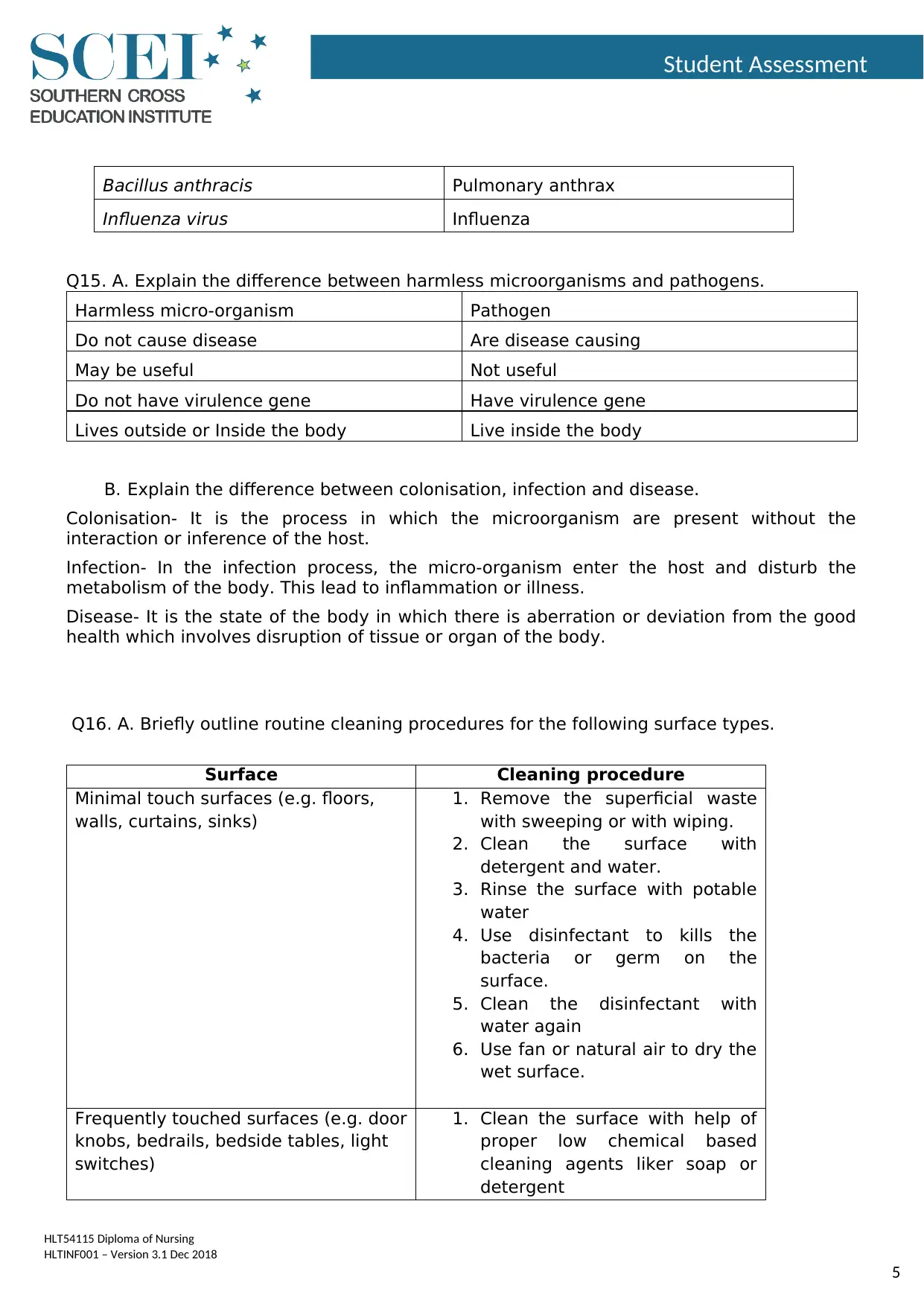
Student Assessment
Bacillus anthracis Pulmonary anthrax
Influenza virus Influenza
Q15. A. Explain the difference between harmless microorganisms and pathogens.
Harmless micro-organism Pathogen
Do not cause disease Are disease causing
May be useful Not useful
Do not have virulence gene Have virulence gene
Lives outside or Inside the body Live inside the body
B. Explain the difference between colonisation, infection and disease.
Colonisation- It is the process in which the microorganism are present without the
interaction or inference of the host.
Infection- In the infection process, the micro-organism enter the host and disturb the
metabolism of the body. This lead to inflammation or illness.
Disease- It is the state of the body in which there is aberration or deviation from the good
health which involves disruption of tissue or organ of the body.
Q16. A. Briefly outline routine cleaning procedures for the following surface types.
Surface Cleaning procedure
Minimal touch surfaces (e.g. floors,
walls, curtains, sinks)
1. Remove the superficial waste
with sweeping or with wiping.
2. Clean the surface with
detergent and water.
3. Rinse the surface with potable
water
4. Use disinfectant to kills the
bacteria or germ on the
surface.
5. Clean the disinfectant with
water again
6. Use fan or natural air to dry the
wet surface.
Frequently touched surfaces (e.g. door
knobs, bedrails, bedside tables, light
switches)
1. Clean the surface with help of
proper low chemical based
cleaning agents liker soap or
detergent
HLT54115 Diploma of Nursing
HLTINF001 – Version 3.1 Dec 2018
5
Bacillus anthracis Pulmonary anthrax
Influenza virus Influenza
Q15. A. Explain the difference between harmless microorganisms and pathogens.
Harmless micro-organism Pathogen
Do not cause disease Are disease causing
May be useful Not useful
Do not have virulence gene Have virulence gene
Lives outside or Inside the body Live inside the body
B. Explain the difference between colonisation, infection and disease.
Colonisation- It is the process in which the microorganism are present without the
interaction or inference of the host.
Infection- In the infection process, the micro-organism enter the host and disturb the
metabolism of the body. This lead to inflammation or illness.
Disease- It is the state of the body in which there is aberration or deviation from the good
health which involves disruption of tissue or organ of the body.
Q16. A. Briefly outline routine cleaning procedures for the following surface types.
Surface Cleaning procedure
Minimal touch surfaces (e.g. floors,
walls, curtains, sinks)
1. Remove the superficial waste
with sweeping or with wiping.
2. Clean the surface with
detergent and water.
3. Rinse the surface with potable
water
4. Use disinfectant to kills the
bacteria or germ on the
surface.
5. Clean the disinfectant with
water again
6. Use fan or natural air to dry the
wet surface.
Frequently touched surfaces (e.g. door
knobs, bedrails, bedside tables, light
switches)
1. Clean the surface with help of
proper low chemical based
cleaning agents liker soap or
detergent
HLT54115 Diploma of Nursing
HLTINF001 – Version 3.1 Dec 2018
5
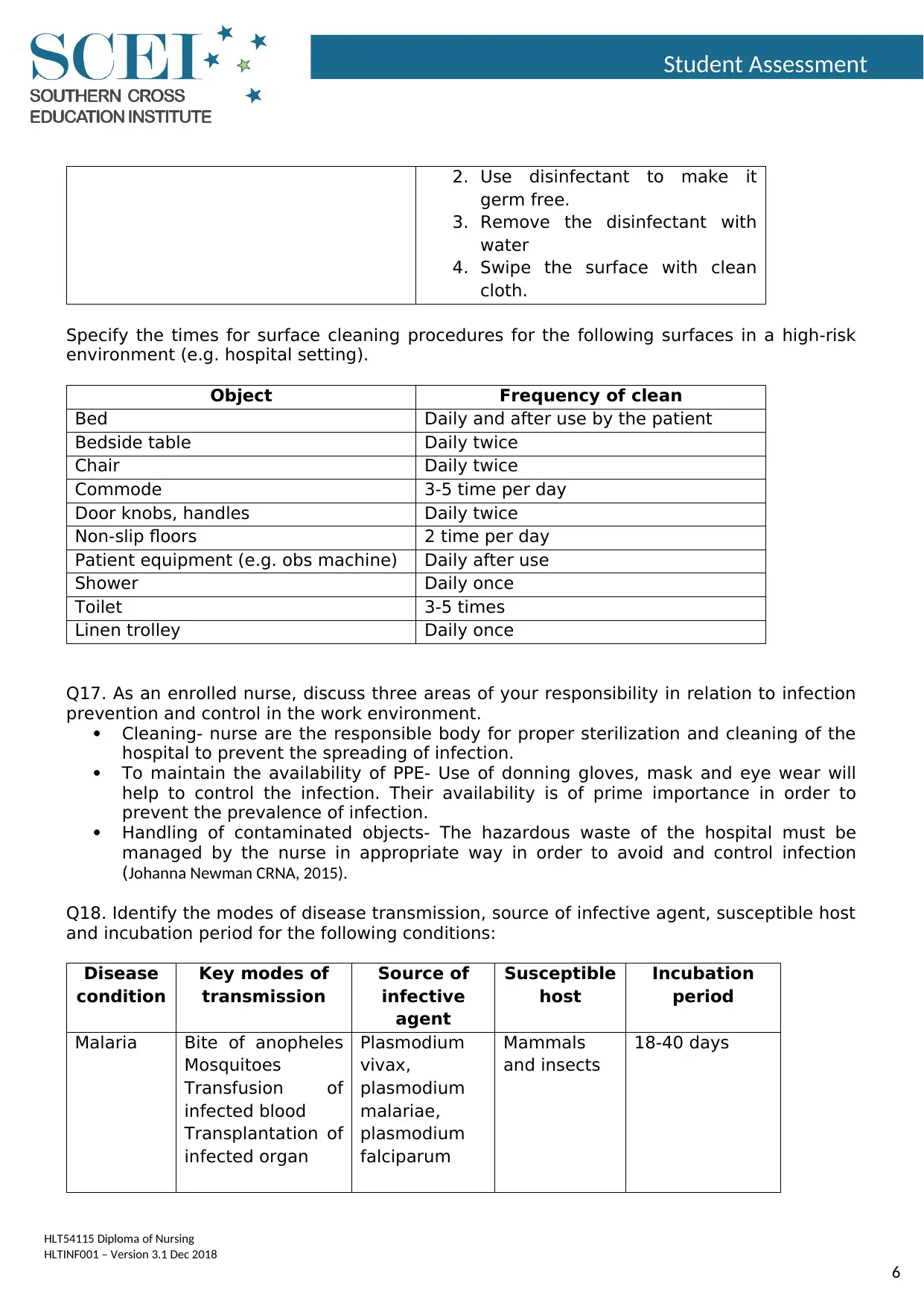
Student Assessment
2. Use disinfectant to make it
germ free.
3. Remove the disinfectant with
water
4. Swipe the surface with clean
cloth.
Specify the times for surface cleaning procedures for the following surfaces in a high-risk
environment (e.g. hospital setting).
Object Frequency of clean
Bed Daily and after use by the patient
Bedside table Daily twice
Chair Daily twice
Commode 3-5 time per day
Door knobs, handles Daily twice
Non-slip floors 2 time per day
Patient equipment (e.g. obs machine) Daily after use
Shower Daily once
Toilet 3-5 times
Linen trolley Daily once
Q17. As an enrolled nurse, discuss three areas of your responsibility in relation to infection
prevention and control in the work environment.
Cleaning- nurse are the responsible body for proper sterilization and cleaning of the
hospital to prevent the spreading of infection.
To maintain the availability of PPE- Use of donning gloves, mask and eye wear will
help to control the infection. Their availability is of prime importance in order to
prevent the prevalence of infection.
Handling of contaminated objects- The hazardous waste of the hospital must be
managed by the nurse in appropriate way in order to avoid and control infection
(Johanna Newman CRNA, 2015).
Q18. Identify the modes of disease transmission, source of infective agent, susceptible host
and incubation period for the following conditions:
Disease
condition
Key modes of
transmission
Source of
infective
agent
Susceptible
host
Incubation
period
Malaria Bite of anopheles
Mosquitoes
Transfusion of
infected blood
Transplantation of
infected organ
Plasmodium
vivax,
plasmodium
malariae,
plasmodium
falciparum
Mammals
and insects
18-40 days
HLT54115 Diploma of Nursing
HLTINF001 – Version 3.1 Dec 2018
6
2. Use disinfectant to make it
germ free.
3. Remove the disinfectant with
water
4. Swipe the surface with clean
cloth.
Specify the times for surface cleaning procedures for the following surfaces in a high-risk
environment (e.g. hospital setting).
Object Frequency of clean
Bed Daily and after use by the patient
Bedside table Daily twice
Chair Daily twice
Commode 3-5 time per day
Door knobs, handles Daily twice
Non-slip floors 2 time per day
Patient equipment (e.g. obs machine) Daily after use
Shower Daily once
Toilet 3-5 times
Linen trolley Daily once
Q17. As an enrolled nurse, discuss three areas of your responsibility in relation to infection
prevention and control in the work environment.
Cleaning- nurse are the responsible body for proper sterilization and cleaning of the
hospital to prevent the spreading of infection.
To maintain the availability of PPE- Use of donning gloves, mask and eye wear will
help to control the infection. Their availability is of prime importance in order to
prevent the prevalence of infection.
Handling of contaminated objects- The hazardous waste of the hospital must be
managed by the nurse in appropriate way in order to avoid and control infection
(Johanna Newman CRNA, 2015).
Q18. Identify the modes of disease transmission, source of infective agent, susceptible host
and incubation period for the following conditions:
Disease
condition
Key modes of
transmission
Source of
infective
agent
Susceptible
host
Incubation
period
Malaria Bite of anopheles
Mosquitoes
Transfusion of
infected blood
Transplantation of
infected organ
Plasmodium
vivax,
plasmodium
malariae,
plasmodium
falciparum
Mammals
and insects
18-40 days
HLT54115 Diploma of Nursing
HLTINF001 – Version 3.1 Dec 2018
6
⊘ This is a preview!⊘
Do you want full access?
Subscribe today to unlock all pages.

Trusted by 1+ million students worldwide
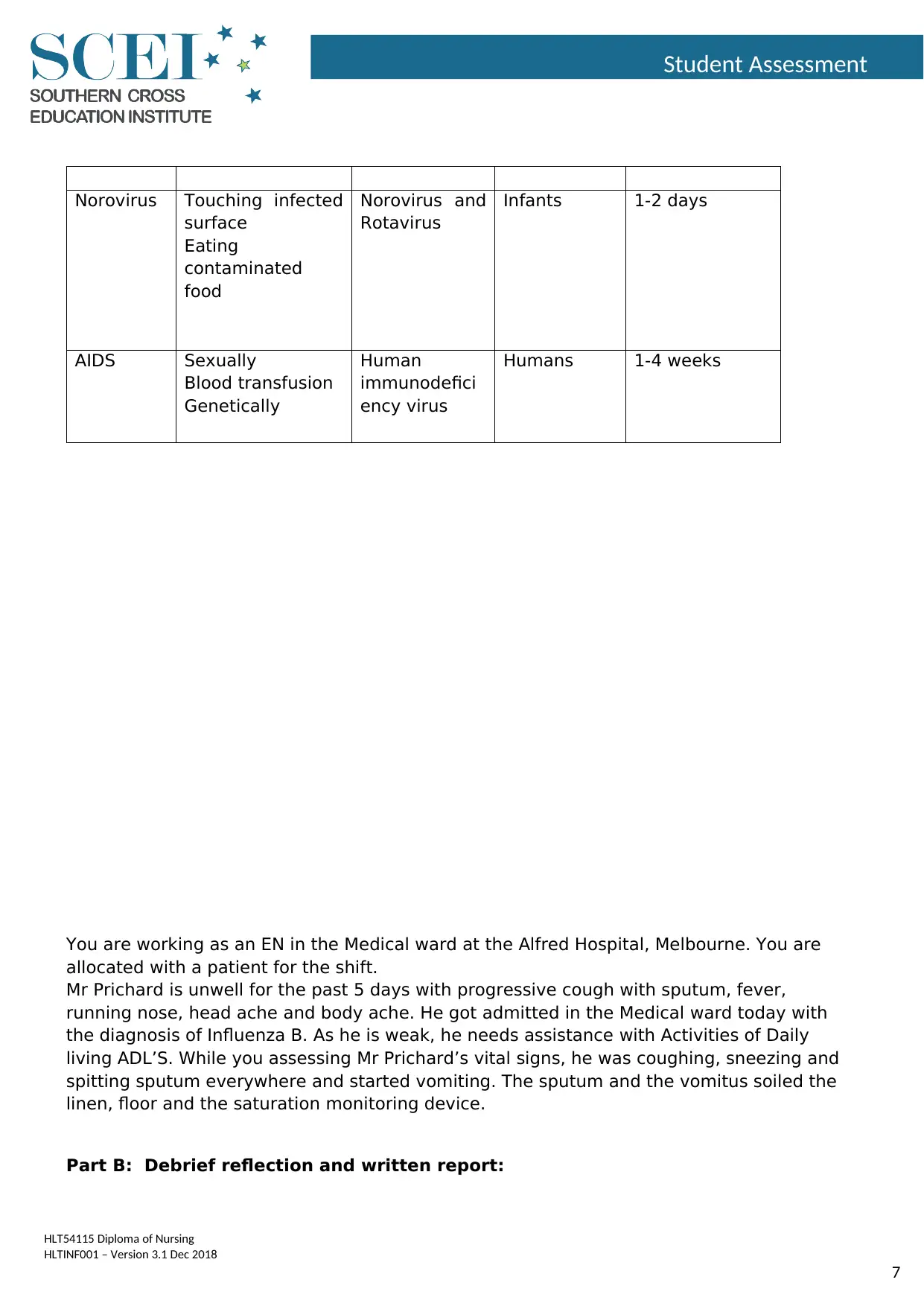
Student Assessment
Norovirus Touching infected
surface
Eating
contaminated
food
Norovirus and
Rotavirus
Infants 1-2 days
AIDS Sexually
Blood transfusion
Genetically
Human
immunodefici
ency virus
Humans 1-4 weeks
You are working as an EN in the Medical ward at the Alfred Hospital, Melbourne. You are
allocated with a patient for the shift.
Mr Prichard is unwell for the past 5 days with progressive cough with sputum, fever,
running nose, head ache and body ache. He got admitted in the Medical ward today with
the diagnosis of Influenza B. As he is weak, he needs assistance with Activities of Daily
living ADL’S. While you assessing Mr Prichard’s vital signs, he was coughing, sneezing and
spitting sputum everywhere and started vomiting. The sputum and the vomitus soiled the
linen, floor and the saturation monitoring device.
Part B: Debrief reflection and written report:
HLT54115 Diploma of Nursing
HLTINF001 – Version 3.1 Dec 2018
7
Norovirus Touching infected
surface
Eating
contaminated
food
Norovirus and
Rotavirus
Infants 1-2 days
AIDS Sexually
Blood transfusion
Genetically
Human
immunodefici
ency virus
Humans 1-4 weeks
You are working as an EN in the Medical ward at the Alfred Hospital, Melbourne. You are
allocated with a patient for the shift.
Mr Prichard is unwell for the past 5 days with progressive cough with sputum, fever,
running nose, head ache and body ache. He got admitted in the Medical ward today with
the diagnosis of Influenza B. As he is weak, he needs assistance with Activities of Daily
living ADL’S. While you assessing Mr Prichard’s vital signs, he was coughing, sneezing and
spitting sputum everywhere and started vomiting. The sputum and the vomitus soiled the
linen, floor and the saturation monitoring device.
Part B: Debrief reflection and written report:
HLT54115 Diploma of Nursing
HLTINF001 – Version 3.1 Dec 2018
7
Paraphrase This Document
Need a fresh take? Get an instant paraphrase of this document with our AI Paraphraser
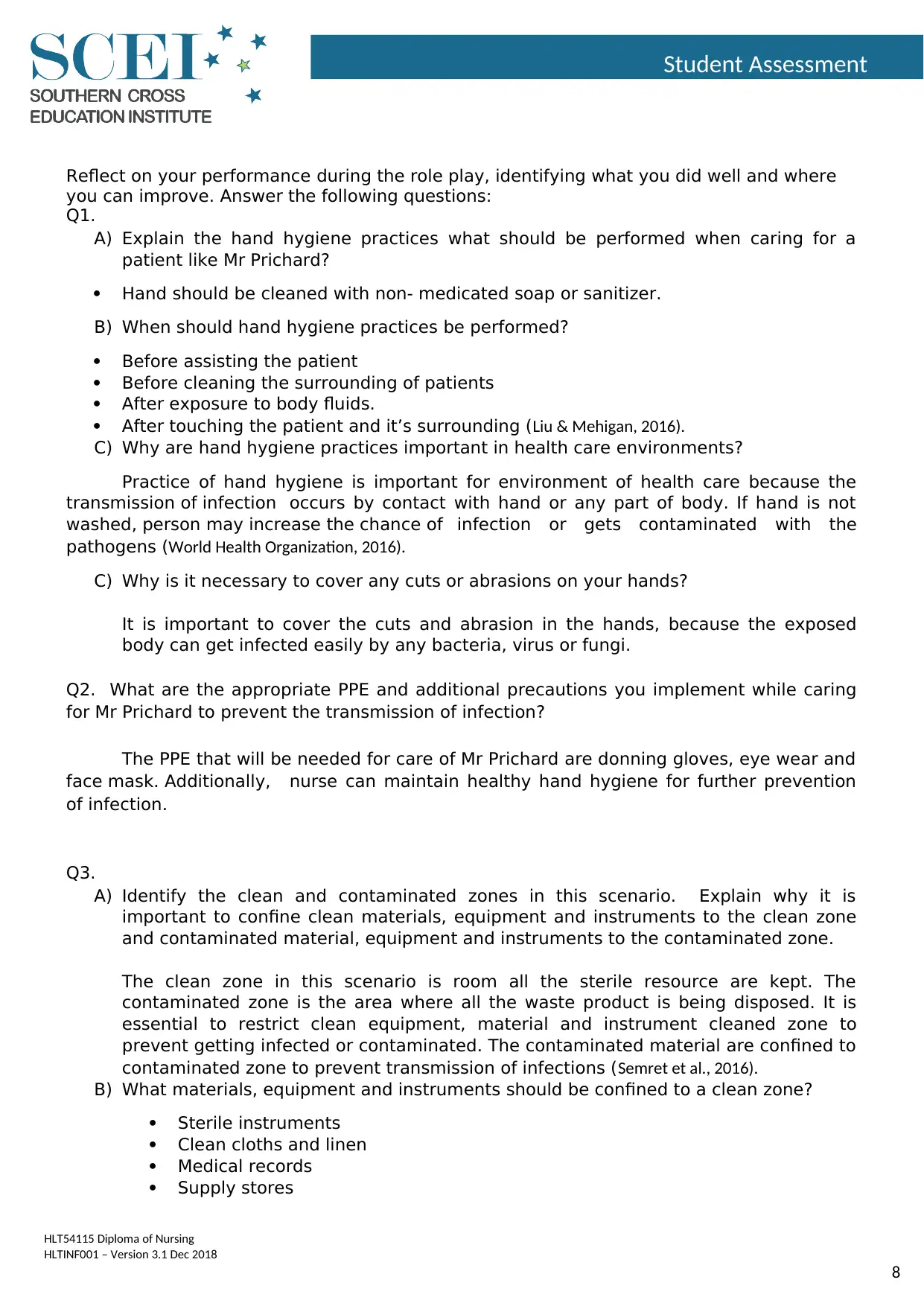
Student Assessment
Reflect on your performance during the role play, identifying what you did well and where
you can improve. Answer the following questions:
Q1.
A) Explain the hand hygiene practices what should be performed when caring for a
patient like Mr Prichard?
Hand should be cleaned with non- medicated soap or sanitizer.
B) When should hand hygiene practices be performed?
Before assisting the patient
Before cleaning the surrounding of patients
After exposure to body fluids.
After touching the patient and it’s surrounding (Liu & Mehigan, 2016).
C) Why are hand hygiene practices important in health care environments?
Practice of hand hygiene is important for environment of health care because the
transmission of infection occurs by contact with hand or any part of body. If hand is not
washed, person may increase the chance of infection or gets contaminated with the
pathogens (World Health Organization, 2016).
C) Why is it necessary to cover any cuts or abrasions on your hands?
It is important to cover the cuts and abrasion in the hands, because the exposed
body can get infected easily by any bacteria, virus or fungi.
Q2. What are the appropriate PPE and additional precautions you implement while caring
for Mr Prichard to prevent the transmission of infection?
The PPE that will be needed for care of Mr Prichard are donning gloves, eye wear and
face mask. Additionally, nurse can maintain healthy hand hygiene for further prevention
of infection.
Q3.
A) Identify the clean and contaminated zones in this scenario. Explain why it is
important to confine clean materials, equipment and instruments to the clean zone
and contaminated material, equipment and instruments to the contaminated zone.
The clean zone in this scenario is room all the sterile resource are kept. The
contaminated zone is the area where all the waste product is being disposed. It is
essential to restrict clean equipment, material and instrument cleaned zone to
prevent getting infected or contaminated. The contaminated material are confined to
contaminated zone to prevent transmission of infections (Semret et al., 2016).
B) What materials, equipment and instruments should be confined to a clean zone?
Sterile instruments
Clean cloths and linen
Medical records
Supply stores
HLT54115 Diploma of Nursing
HLTINF001 – Version 3.1 Dec 2018
8
Reflect on your performance during the role play, identifying what you did well and where
you can improve. Answer the following questions:
Q1.
A) Explain the hand hygiene practices what should be performed when caring for a
patient like Mr Prichard?
Hand should be cleaned with non- medicated soap or sanitizer.
B) When should hand hygiene practices be performed?
Before assisting the patient
Before cleaning the surrounding of patients
After exposure to body fluids.
After touching the patient and it’s surrounding (Liu & Mehigan, 2016).
C) Why are hand hygiene practices important in health care environments?
Practice of hand hygiene is important for environment of health care because the
transmission of infection occurs by contact with hand or any part of body. If hand is not
washed, person may increase the chance of infection or gets contaminated with the
pathogens (World Health Organization, 2016).
C) Why is it necessary to cover any cuts or abrasions on your hands?
It is important to cover the cuts and abrasion in the hands, because the exposed
body can get infected easily by any bacteria, virus or fungi.
Q2. What are the appropriate PPE and additional precautions you implement while caring
for Mr Prichard to prevent the transmission of infection?
The PPE that will be needed for care of Mr Prichard are donning gloves, eye wear and
face mask. Additionally, nurse can maintain healthy hand hygiene for further prevention
of infection.
Q3.
A) Identify the clean and contaminated zones in this scenario. Explain why it is
important to confine clean materials, equipment and instruments to the clean zone
and contaminated material, equipment and instruments to the contaminated zone.
The clean zone in this scenario is room all the sterile resource are kept. The
contaminated zone is the area where all the waste product is being disposed. It is
essential to restrict clean equipment, material and instrument cleaned zone to
prevent getting infected or contaminated. The contaminated material are confined to
contaminated zone to prevent transmission of infections (Semret et al., 2016).
B) What materials, equipment and instruments should be confined to a clean zone?
Sterile instruments
Clean cloths and linen
Medical records
Supply stores
HLT54115 Diploma of Nursing
HLTINF001 – Version 3.1 Dec 2018
8
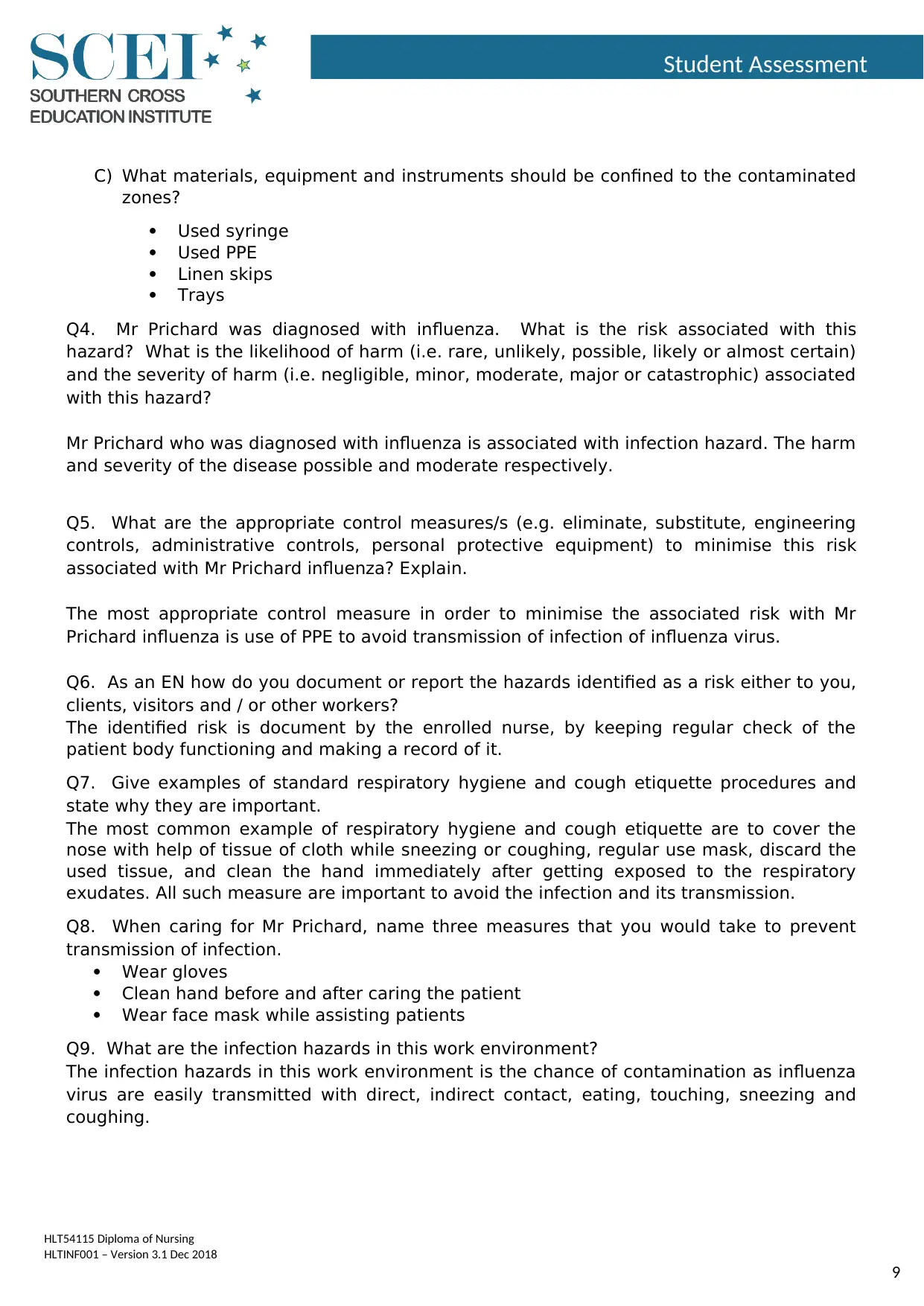
Student Assessment
C) What materials, equipment and instruments should be confined to the contaminated
zones?
Used syringe
Used PPE
Linen skips
Trays
Q4. Mr Prichard was diagnosed with influenza. What is the risk associated with this
hazard? What is the likelihood of harm (i.e. rare, unlikely, possible, likely or almost certain)
and the severity of harm (i.e. negligible, minor, moderate, major or catastrophic) associated
with this hazard?
Mr Prichard who was diagnosed with influenza is associated with infection hazard. The harm
and severity of the disease possible and moderate respectively.
Q5. What are the appropriate control measures/s (e.g. eliminate, substitute, engineering
controls, administrative controls, personal protective equipment) to minimise this risk
associated with Mr Prichard influenza? Explain.
The most appropriate control measure in order to minimise the associated risk with Mr
Prichard influenza is use of PPE to avoid transmission of infection of influenza virus.
Q6. As an EN how do you document or report the hazards identified as a risk either to you,
clients, visitors and / or other workers?
The identified risk is document by the enrolled nurse, by keeping regular check of the
patient body functioning and making a record of it.
Q7. Give examples of standard respiratory hygiene and cough etiquette procedures and
state why they are important.
The most common example of respiratory hygiene and cough etiquette are to cover the
nose with help of tissue of cloth while sneezing or coughing, regular use mask, discard the
used tissue, and clean the hand immediately after getting exposed to the respiratory
exudates. All such measure are important to avoid the infection and its transmission.
Q8. When caring for Mr Prichard, name three measures that you would take to prevent
transmission of infection.
Wear gloves
Clean hand before and after caring the patient
Wear face mask while assisting patients
Q9. What are the infection hazards in this work environment?
The infection hazards in this work environment is the chance of contamination as influenza
virus are easily transmitted with direct, indirect contact, eating, touching, sneezing and
coughing.
HLT54115 Diploma of Nursing
HLTINF001 – Version 3.1 Dec 2018
9
C) What materials, equipment and instruments should be confined to the contaminated
zones?
Used syringe
Used PPE
Linen skips
Trays
Q4. Mr Prichard was diagnosed with influenza. What is the risk associated with this
hazard? What is the likelihood of harm (i.e. rare, unlikely, possible, likely or almost certain)
and the severity of harm (i.e. negligible, minor, moderate, major or catastrophic) associated
with this hazard?
Mr Prichard who was diagnosed with influenza is associated with infection hazard. The harm
and severity of the disease possible and moderate respectively.
Q5. What are the appropriate control measures/s (e.g. eliminate, substitute, engineering
controls, administrative controls, personal protective equipment) to minimise this risk
associated with Mr Prichard influenza? Explain.
The most appropriate control measure in order to minimise the associated risk with Mr
Prichard influenza is use of PPE to avoid transmission of infection of influenza virus.
Q6. As an EN how do you document or report the hazards identified as a risk either to you,
clients, visitors and / or other workers?
The identified risk is document by the enrolled nurse, by keeping regular check of the
patient body functioning and making a record of it.
Q7. Give examples of standard respiratory hygiene and cough etiquette procedures and
state why they are important.
The most common example of respiratory hygiene and cough etiquette are to cover the
nose with help of tissue of cloth while sneezing or coughing, regular use mask, discard the
used tissue, and clean the hand immediately after getting exposed to the respiratory
exudates. All such measure are important to avoid the infection and its transmission.
Q8. When caring for Mr Prichard, name three measures that you would take to prevent
transmission of infection.
Wear gloves
Clean hand before and after caring the patient
Wear face mask while assisting patients
Q9. What are the infection hazards in this work environment?
The infection hazards in this work environment is the chance of contamination as influenza
virus are easily transmitted with direct, indirect contact, eating, touching, sneezing and
coughing.
HLT54115 Diploma of Nursing
HLTINF001 – Version 3.1 Dec 2018
9
⊘ This is a preview!⊘
Do you want full access?
Subscribe today to unlock all pages.

Trusted by 1+ million students worldwide
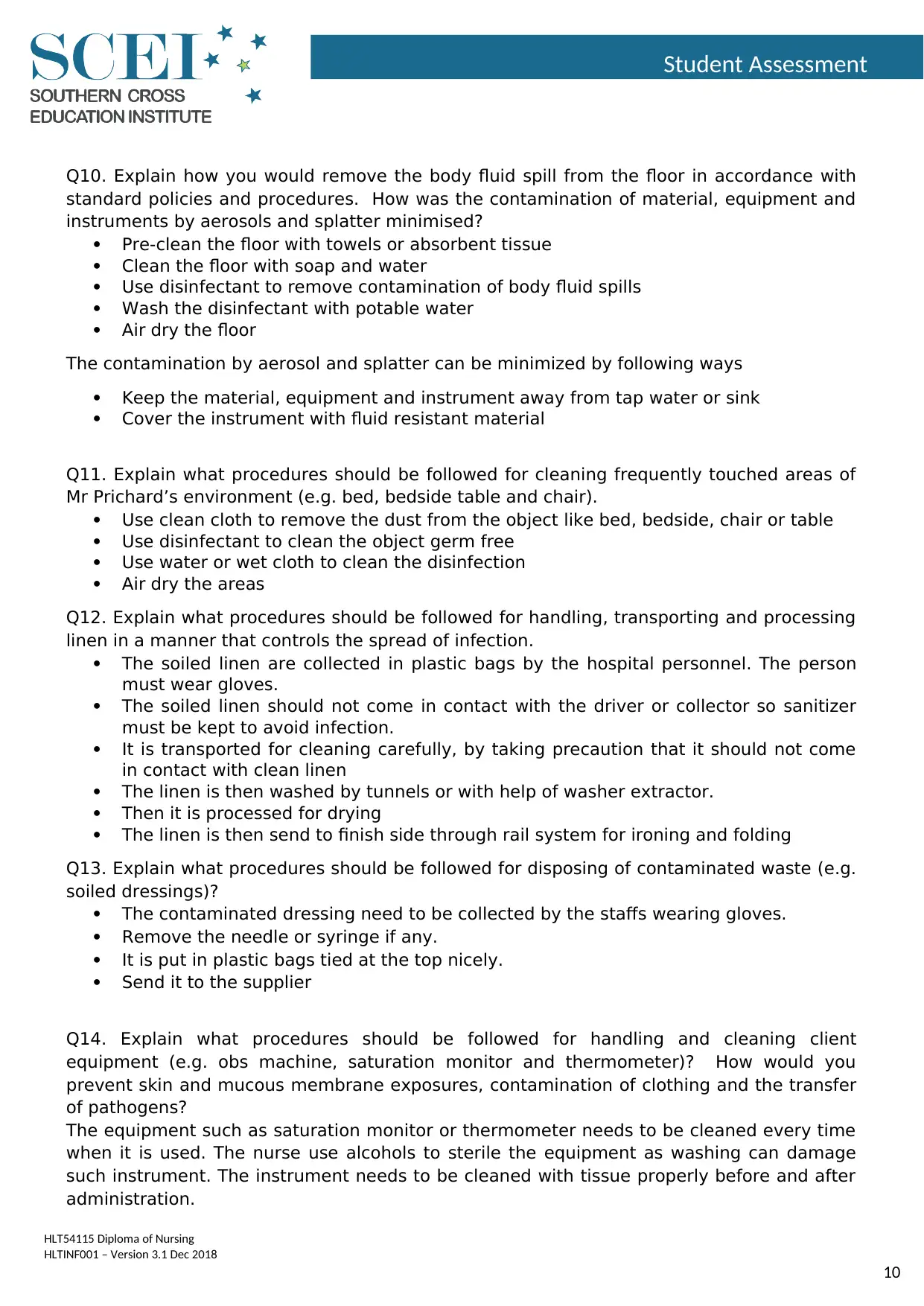
Student Assessment
Q10. Explain how you would remove the body fluid spill from the floor in accordance with
standard policies and procedures. How was the contamination of material, equipment and
instruments by aerosols and splatter minimised?
Pre-clean the floor with towels or absorbent tissue
Clean the floor with soap and water
Use disinfectant to remove contamination of body fluid spills
Wash the disinfectant with potable water
Air dry the floor
The contamination by aerosol and splatter can be minimized by following ways
Keep the material, equipment and instrument away from tap water or sink
Cover the instrument with fluid resistant material
Q11. Explain what procedures should be followed for cleaning frequently touched areas of
Mr Prichard’s environment (e.g. bed, bedside table and chair).
Use clean cloth to remove the dust from the object like bed, bedside, chair or table
Use disinfectant to clean the object germ free
Use water or wet cloth to clean the disinfection
Air dry the areas
Q12. Explain what procedures should be followed for handling, transporting and processing
linen in a manner that controls the spread of infection.
The soiled linen are collected in plastic bags by the hospital personnel. The person
must wear gloves.
The soiled linen should not come in contact with the driver or collector so sanitizer
must be kept to avoid infection.
It is transported for cleaning carefully, by taking precaution that it should not come
in contact with clean linen
The linen is then washed by tunnels or with help of washer extractor.
Then it is processed for drying
The linen is then send to finish side through rail system for ironing and folding
Q13. Explain what procedures should be followed for disposing of contaminated waste (e.g.
soiled dressings)?
The contaminated dressing need to be collected by the staffs wearing gloves.
Remove the needle or syringe if any.
It is put in plastic bags tied at the top nicely.
Send it to the supplier
Q14. Explain what procedures should be followed for handling and cleaning client
equipment (e.g. obs machine, saturation monitor and thermometer)? How would you
prevent skin and mucous membrane exposures, contamination of clothing and the transfer
of pathogens?
The equipment such as saturation monitor or thermometer needs to be cleaned every time
when it is used. The nurse use alcohols to sterile the equipment as washing can damage
such instrument. The instrument needs to be cleaned with tissue properly before and after
administration.
HLT54115 Diploma of Nursing
HLTINF001 – Version 3.1 Dec 2018
10
Q10. Explain how you would remove the body fluid spill from the floor in accordance with
standard policies and procedures. How was the contamination of material, equipment and
instruments by aerosols and splatter minimised?
Pre-clean the floor with towels or absorbent tissue
Clean the floor with soap and water
Use disinfectant to remove contamination of body fluid spills
Wash the disinfectant with potable water
Air dry the floor
The contamination by aerosol and splatter can be minimized by following ways
Keep the material, equipment and instrument away from tap water or sink
Cover the instrument with fluid resistant material
Q11. Explain what procedures should be followed for cleaning frequently touched areas of
Mr Prichard’s environment (e.g. bed, bedside table and chair).
Use clean cloth to remove the dust from the object like bed, bedside, chair or table
Use disinfectant to clean the object germ free
Use water or wet cloth to clean the disinfection
Air dry the areas
Q12. Explain what procedures should be followed for handling, transporting and processing
linen in a manner that controls the spread of infection.
The soiled linen are collected in plastic bags by the hospital personnel. The person
must wear gloves.
The soiled linen should not come in contact with the driver or collector so sanitizer
must be kept to avoid infection.
It is transported for cleaning carefully, by taking precaution that it should not come
in contact with clean linen
The linen is then washed by tunnels or with help of washer extractor.
Then it is processed for drying
The linen is then send to finish side through rail system for ironing and folding
Q13. Explain what procedures should be followed for disposing of contaminated waste (e.g.
soiled dressings)?
The contaminated dressing need to be collected by the staffs wearing gloves.
Remove the needle or syringe if any.
It is put in plastic bags tied at the top nicely.
Send it to the supplier
Q14. Explain what procedures should be followed for handling and cleaning client
equipment (e.g. obs machine, saturation monitor and thermometer)? How would you
prevent skin and mucous membrane exposures, contamination of clothing and the transfer
of pathogens?
The equipment such as saturation monitor or thermometer needs to be cleaned every time
when it is used. The nurse use alcohols to sterile the equipment as washing can damage
such instrument. The instrument needs to be cleaned with tissue properly before and after
administration.
HLT54115 Diploma of Nursing
HLTINF001 – Version 3.1 Dec 2018
10
Paraphrase This Document
Need a fresh take? Get an instant paraphrase of this document with our AI Paraphraser
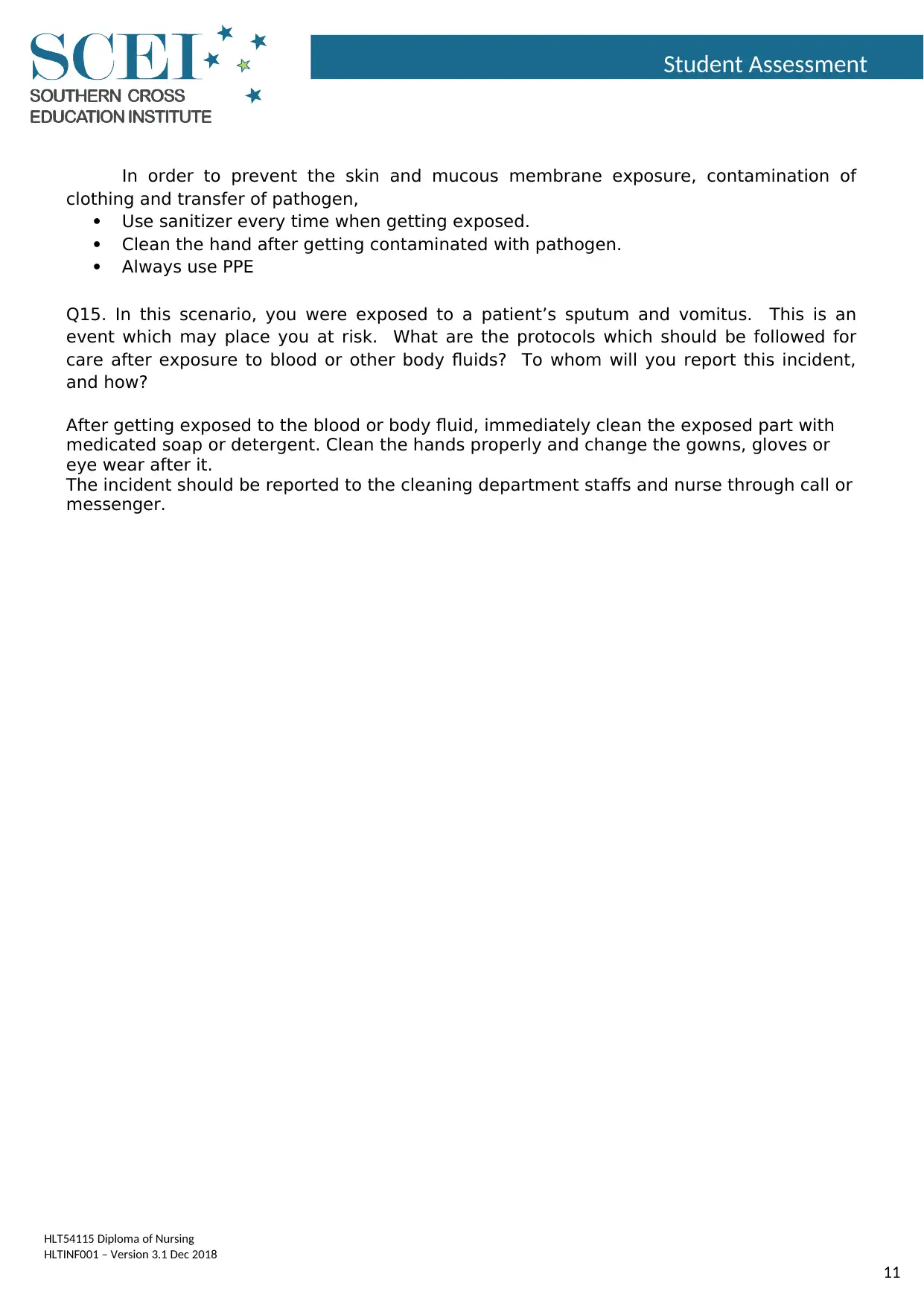
Student Assessment
In order to prevent the skin and mucous membrane exposure, contamination of
clothing and transfer of pathogen,
Use sanitizer every time when getting exposed.
Clean the hand after getting contaminated with pathogen.
Always use PPE
Q15. In this scenario, you were exposed to a patient’s sputum and vomitus. This is an
event which may place you at risk. What are the protocols which should be followed for
care after exposure to blood or other body fluids? To whom will you report this incident,
and how?
After getting exposed to the blood or body fluid, immediately clean the exposed part with
medicated soap or detergent. Clean the hands properly and change the gowns, gloves or
eye wear after it.
The incident should be reported to the cleaning department staffs and nurse through call or
messenger.
HLT54115 Diploma of Nursing
HLTINF001 – Version 3.1 Dec 2018
11
In order to prevent the skin and mucous membrane exposure, contamination of
clothing and transfer of pathogen,
Use sanitizer every time when getting exposed.
Clean the hand after getting contaminated with pathogen.
Always use PPE
Q15. In this scenario, you were exposed to a patient’s sputum and vomitus. This is an
event which may place you at risk. What are the protocols which should be followed for
care after exposure to blood or other body fluids? To whom will you report this incident,
and how?
After getting exposed to the blood or body fluid, immediately clean the exposed part with
medicated soap or detergent. Clean the hands properly and change the gowns, gloves or
eye wear after it.
The incident should be reported to the cleaning department staffs and nurse through call or
messenger.
HLT54115 Diploma of Nursing
HLTINF001 – Version 3.1 Dec 2018
11
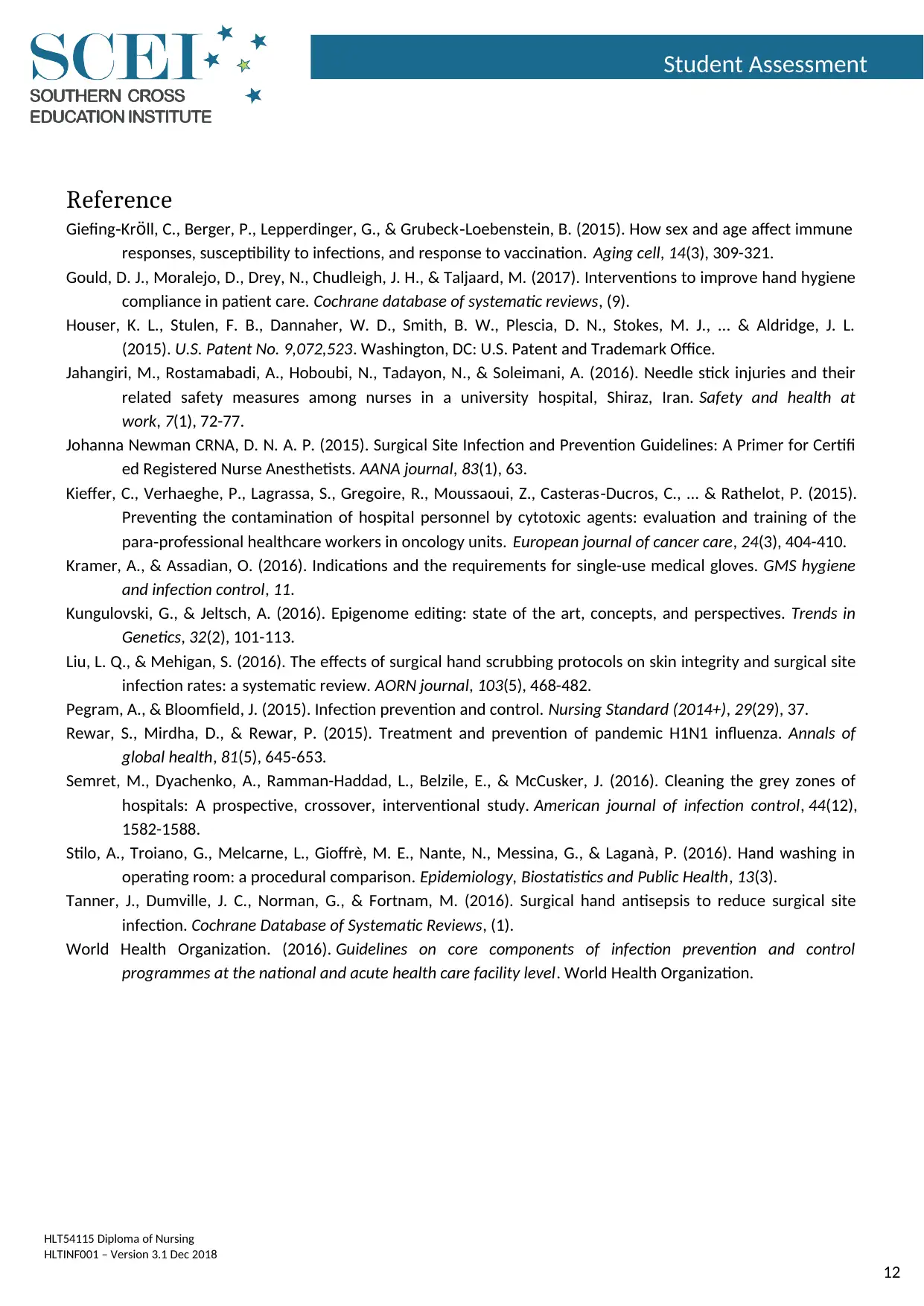
Student Assessment
Reference
Giefing‐Kröll, C., Berger, P., Lepperdinger, G., & Grubeck‐Loebenstein, B. (2015). How sex and age affect immune
responses, susceptibility to infections, and response to vaccination. Aging cell, 14(3), 309-321.
Gould, D. J., Moralejo, D., Drey, N., Chudleigh, J. H., & Taljaard, M. (2017). Interventions to improve hand hygiene
compliance in patient care. Cochrane database of systematic reviews, (9).
Houser, K. L., Stulen, F. B., Dannaher, W. D., Smith, B. W., Plescia, D. N., Stokes, M. J., ... & Aldridge, J. L.
(2015). U.S. Patent No. 9,072,523. Washington, DC: U.S. Patent and Trademark Office.
Jahangiri, M., Rostamabadi, A., Hoboubi, N., Tadayon, N., & Soleimani, A. (2016). Needle stick injuries and their
related safety measures among nurses in a university hospital, Shiraz, Iran. Safety and health at
work, 7(1), 72-77.
Johanna Newman CRNA, D. N. A. P. (2015). Surgical Site Infection and Prevention Guidelines: A Primer for Certifi
ed Registered Nurse Anesthetists. AANA journal, 83(1), 63.
Kieffer, C., Verhaeghe, P., Lagrassa, S., Gregoire, R., Moussaoui, Z., Casteras‐Ducros, C., ... & Rathelot, P. (2015).
Preventing the contamination of hospital personnel by cytotoxic agents: evaluation and training of the
para‐professional healthcare workers in oncology units. European journal of cancer care, 24(3), 404-410.
Kramer, A., & Assadian, O. (2016). Indications and the requirements for single-use medical gloves. GMS hygiene
and infection control, 11.
Kungulovski, G., & Jeltsch, A. (2016). Epigenome editing: state of the art, concepts, and perspectives. Trends in
Genetics, 32(2), 101-113.
Liu, L. Q., & Mehigan, S. (2016). The effects of surgical hand scrubbing protocols on skin integrity and surgical site
infection rates: a systematic review. AORN journal, 103(5), 468-482.
Pegram, A., & Bloomfield, J. (2015). Infection prevention and control. Nursing Standard (2014+), 29(29), 37.
Rewar, S., Mirdha, D., & Rewar, P. (2015). Treatment and prevention of pandemic H1N1 influenza. Annals of
global health, 81(5), 645-653.
Semret, M., Dyachenko, A., Ramman-Haddad, L., Belzile, E., & McCusker, J. (2016). Cleaning the grey zones of
hospitals: A prospective, crossover, interventional study. American journal of infection control, 44(12),
1582-1588.
Stilo, A., Troiano, G., Melcarne, L., Gioffrè, M. E., Nante, N., Messina, G., & Laganà, P. (2016). Hand washing in
operating room: a procedural comparison. Epidemiology, Biostatistics and Public Health, 13(3).
Tanner, J., Dumville, J. C., Norman, G., & Fortnam, M. (2016). Surgical hand antisepsis to reduce surgical site
infection. Cochrane Database of Systematic Reviews, (1).
World Health Organization. (2016). Guidelines on core components of infection prevention and control
programmes at the national and acute health care facility level. World Health Organization.
HLT54115 Diploma of Nursing
HLTINF001 – Version 3.1 Dec 2018
12
Reference
Giefing‐Kröll, C., Berger, P., Lepperdinger, G., & Grubeck‐Loebenstein, B. (2015). How sex and age affect immune
responses, susceptibility to infections, and response to vaccination. Aging cell, 14(3), 309-321.
Gould, D. J., Moralejo, D., Drey, N., Chudleigh, J. H., & Taljaard, M. (2017). Interventions to improve hand hygiene
compliance in patient care. Cochrane database of systematic reviews, (9).
Houser, K. L., Stulen, F. B., Dannaher, W. D., Smith, B. W., Plescia, D. N., Stokes, M. J., ... & Aldridge, J. L.
(2015). U.S. Patent No. 9,072,523. Washington, DC: U.S. Patent and Trademark Office.
Jahangiri, M., Rostamabadi, A., Hoboubi, N., Tadayon, N., & Soleimani, A. (2016). Needle stick injuries and their
related safety measures among nurses in a university hospital, Shiraz, Iran. Safety and health at
work, 7(1), 72-77.
Johanna Newman CRNA, D. N. A. P. (2015). Surgical Site Infection and Prevention Guidelines: A Primer for Certifi
ed Registered Nurse Anesthetists. AANA journal, 83(1), 63.
Kieffer, C., Verhaeghe, P., Lagrassa, S., Gregoire, R., Moussaoui, Z., Casteras‐Ducros, C., ... & Rathelot, P. (2015).
Preventing the contamination of hospital personnel by cytotoxic agents: evaluation and training of the
para‐professional healthcare workers in oncology units. European journal of cancer care, 24(3), 404-410.
Kramer, A., & Assadian, O. (2016). Indications and the requirements for single-use medical gloves. GMS hygiene
and infection control, 11.
Kungulovski, G., & Jeltsch, A. (2016). Epigenome editing: state of the art, concepts, and perspectives. Trends in
Genetics, 32(2), 101-113.
Liu, L. Q., & Mehigan, S. (2016). The effects of surgical hand scrubbing protocols on skin integrity and surgical site
infection rates: a systematic review. AORN journal, 103(5), 468-482.
Pegram, A., & Bloomfield, J. (2015). Infection prevention and control. Nursing Standard (2014+), 29(29), 37.
Rewar, S., Mirdha, D., & Rewar, P. (2015). Treatment and prevention of pandemic H1N1 influenza. Annals of
global health, 81(5), 645-653.
Semret, M., Dyachenko, A., Ramman-Haddad, L., Belzile, E., & McCusker, J. (2016). Cleaning the grey zones of
hospitals: A prospective, crossover, interventional study. American journal of infection control, 44(12),
1582-1588.
Stilo, A., Troiano, G., Melcarne, L., Gioffrè, M. E., Nante, N., Messina, G., & Laganà, P. (2016). Hand washing in
operating room: a procedural comparison. Epidemiology, Biostatistics and Public Health, 13(3).
Tanner, J., Dumville, J. C., Norman, G., & Fortnam, M. (2016). Surgical hand antisepsis to reduce surgical site
infection. Cochrane Database of Systematic Reviews, (1).
World Health Organization. (2016). Guidelines on core components of infection prevention and control
programmes at the national and acute health care facility level. World Health Organization.
HLT54115 Diploma of Nursing
HLTINF001 – Version 3.1 Dec 2018
12
⊘ This is a preview!⊘
Do you want full access?
Subscribe today to unlock all pages.

Trusted by 1+ million students worldwide
1 out of 14
Related Documents
Your All-in-One AI-Powered Toolkit for Academic Success.
+13062052269
info@desklib.com
Available 24*7 on WhatsApp / Email
![[object Object]](/_next/static/media/star-bottom.7253800d.svg)
Unlock your academic potential
Copyright © 2020–2025 A2Z Services. All Rights Reserved. Developed and managed by ZUCOL.



